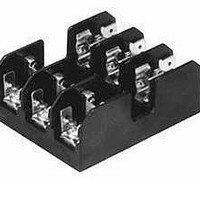BCCM6033PQ Cooper/Bussmann, BCCM6033PQ Datasheet - Page 236

BCCM6033PQ
Manufacturer Part Number
BCCM6033PQ
Description
FUSEBLOCK CLASS CC 13/32X1-1/2"
Manufacturer
Cooper/Bussmann
Series
BCCMr
Type
Blockr
Datasheet
1.BCCM6033SQ.pdf
(240 pages)
Specifications of BCCM6033PQ
Fuse Size
Class CC
Number Of Circuits
3
Mounting Type
Chassis Mount
Termination Style
Pressure Plate
Current Rating
20A
Product
Block
Fuse Size / Group
Class CC
Voltage Rating
600 Volts
Mounting Style
Screw
Body Material
Thermoplastic
Lead Free Status / RoHS Status
Lead free / RoHS Compliant
Voltage
-
Lead Free Status / Rohs Status
Lead free / RoHS Compliant
- Current page: 236 of 240
- Download datasheet (5Mb)
Ohm’s Law
The relationship between voltage, current,
and resistance, expressed by the equation E
= IR, where E is the voltage in volts, I is the
current in amperes, and R is the resistance in
ohms.
One Time Fuses
Generic term used to describe a Class H
nonrenewable cartridge fuse, with a single
element.
Overcurrent
A condition which exists on an electrical
circuit when the normal load current is
exceeded. Overcurrents take on two separate
characteristics—overloads and short circuits.
Overload
Can be classified as an overcurrent which
exceeds the normal full load current of a circuit.
Also characteristic of this type of overcurrent is
that it does not leave the normal current car-
rying path of the circuit—that is, it flows from
the source, through the conductors, through
the load, back through the conductors, to the
source again.
Peak Let-Through Current, lp
The instantaneous value of peak current let-
through by a current-limiting fuse, when it
operates in its current-limiting range.
Renewable Fuse (600V & below)
A fuse in which the element, typically a zinc
link, may be replaced after the fuse has
opened, and then reused. Renewable fuses
are made to Class H standards.
Resistive Load
An electrical load which is characteristic of
not having any significant inrush current.
When a resistive load is energized, the current
rises instantly to its steady-state value, with-
out first rising to a higher value.
232
Glossary of Terms
R.M.S. Current
The R.M.S. (root-mean-square) value of any
periodic current is equal to the value of the
direct current which, flowing through a resis-
tance, produces the same heating effect in
the resistance as the periodic current does.
Semiconductor Fuses
Fuses used to protect solid-state devices.
See “High Speed Fuses”.
Short Circuit
Can be classified as an overcurrent which
exceeds the normal full load current of a cir-
cuit by a factor many times (tens, hundreds or
thousands greater). Also characteristic of this
type of overcurrent is that it leaves the normal
current carrying path of the circuit—it takes a
“short cut” around the load and back to the
source.
Short-Circuit Rating
The maximum short-circuit current an electri-
cal component can sustain without the occur-
rence of excessive damage when protected
with an overcurrent protective device.
Short-Circuit Withstand Rating
Same definition as short-circuit rating.
Single Phasing
That condition which occurs when one phase
of a three phase system opens, either in a low
voltage (secondary) or high voltage (primary)
distribution system. Primary or secondary sin-
gle phasing can be caused by any number of
events. This condition results in unbalanced
currents in polyphase motors and unless pro-
tective measures are taken, causes overheat-
ing and failure.
Threshold Current
The symmetrical RMS available current at the
threshold of the current-limiting range, where
the fuse becomes current-limiting when test-
ed to the industry standard. This value can be
read off of a peak let-through chart where the
fuse curve intersects the A-B line. A threshold
ratio is the relationship of the threshold cur-
rent to the fuse’s continuous current rating.
Time-Delay Fuse
A fuse with a built-in delay that allows tempo-
rary and harmless inrush currents to pass
without opening, but is so designed to open
on sustained overloads and short circuits.
Voltage Rating
The maximum open circuit voltage in which a
fuse can be used, yet safely interrupt an over-
current. Exceeding the voltage rating of a fuse
impairs its ability to clear an overload or short
circuit safely.
Withstand Rating
The maximum current that an unprotected
electrical component can sustain for a speci-
fied period of time without the occurrence of
extensive damage.
Bussmann
®
Related parts for BCCM6033PQ
Image
Part Number
Description
Manufacturer
Datasheet
Request
R

Part Number:
Description:
FUSEBLOCK CLASS CC 13/32X1-1/2"
Manufacturer:
Cooper/Bussmann
Datasheet:

Part Number:
Description:
Manufacturer:
Cooper/Bussmann
Datasheet:

Part Number:
Description:
Manufacturer:
Cooper/Bussmann
Datasheet:










